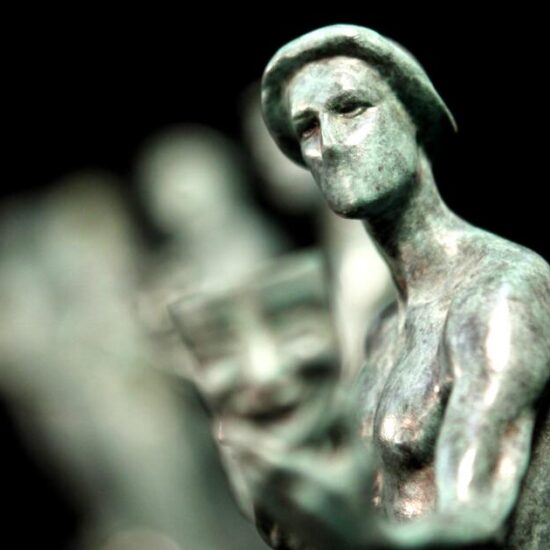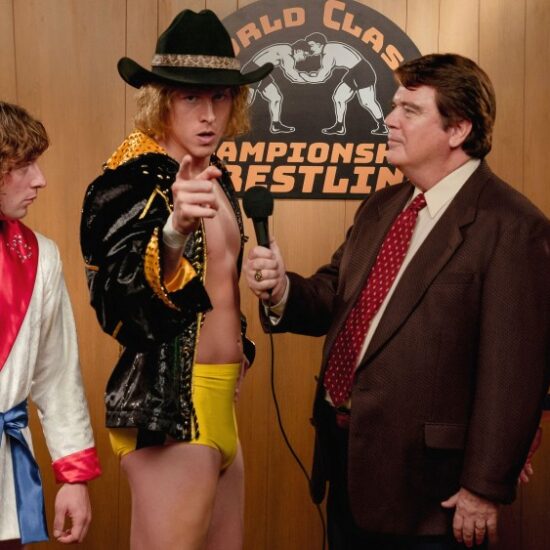
“Tell me your favorite Stephen Sondheim lyric.”
The task stumped each of the actors. “I have a ton, but I’d have to really think about it to narrow it down to one,” said Katie Rose Clarke. And Montego Glover asked, “Does ‘all of them’ qualify as an answer?”
Annaleigh Ashford then shared a pick. “Stop worrying if your vision is new. Let others make that decision — they usually do. You keep moving on,” she said, quoting the musical “Sunday in the Park With George.” “I find that to be even more impactful as artists. It’s like, don’t listen to what anybody else says, because they’re always gonna have an opinion anyway.”
Stephen Sondheim, who wrote the music and lyrics of “Sweeney Todd,” “Company,” “Into the Woods,” “A Little Night Music” and “Merrily We Roll Along,” among many others.
(Hulton Deutsch / Corbis via Getty Images)
The group nodded enthusiastically — all eyes are on them as they work on new visions of works by Sondheim, who died in late 2021. Ashford currently plays deadly pie shop owner Mrs. Lovett in the gothic “Sweeney Todd” on Broadway; Merle Dandridge stars as glamorous actor Desiree Armfeldt in the romantic web “A Little Night Music,” running at the Pasadena Playhouse through May 28; and Glover, as the commanding but conflicted Witch, leads the national tour of the fairy-tale-based “Into the Woods” (which arrives at the Ahmanson Theatre in late June).
Later this year, Clarke reprises her off-Broadway performance as devoted wife Beth in the reverse-chronological “Merrily We Roll Along” on Broadway; and Britney Coleman kicks off the national tour of “Company,” as perennial singleton Bobbie in the gender-flipped Broadway production (which stops at the Pantages Theatre next summer).
The Times recently gathered these five actors for a discussion about the art of making art: what lessons they’re discovering in texts they thought they already knew well, how they conquer their score’s trickiest rhythms and emotional leaps, and whether these once-experimental works are resonating with today’s audiences. The following conversation has been edited for clarity and length.


(Dania Maxwell / Los Angeles Times)
“I honestly think that Sondheim was my first therapist.”
— Merle Dandridge

Do you remember your first time encountering a Sondheim work?
Ashford: I know it sounds strange, but one of the first songs I ever sang as an 8- or 9-year-old girl was “Everything’s Coming Up Roses” [from “Gypsy”]. I remember, even as a little person, understanding that those lyrics were special and they told a story in a different way. As I got more familiar with his work, I learned from my theater community that Sondheim was the goal, and that if you get the opportunity to do Sondheim, you take it, no matter what time and space and place it is.
Glover: Mine was an undergrad class about the history of music theater. I remember thinking, “It doesn’t sound like the other things we’ve been learning about.” He doesn’t write like other people; the structure, the subject matter is different. I felt a real shift, into something that felt closer to me. Then I got cast as Little Red [Riding Hood] in “Into the Woods,” and I was so excited to be on my feet, working on a Sondheim piece for the first time.
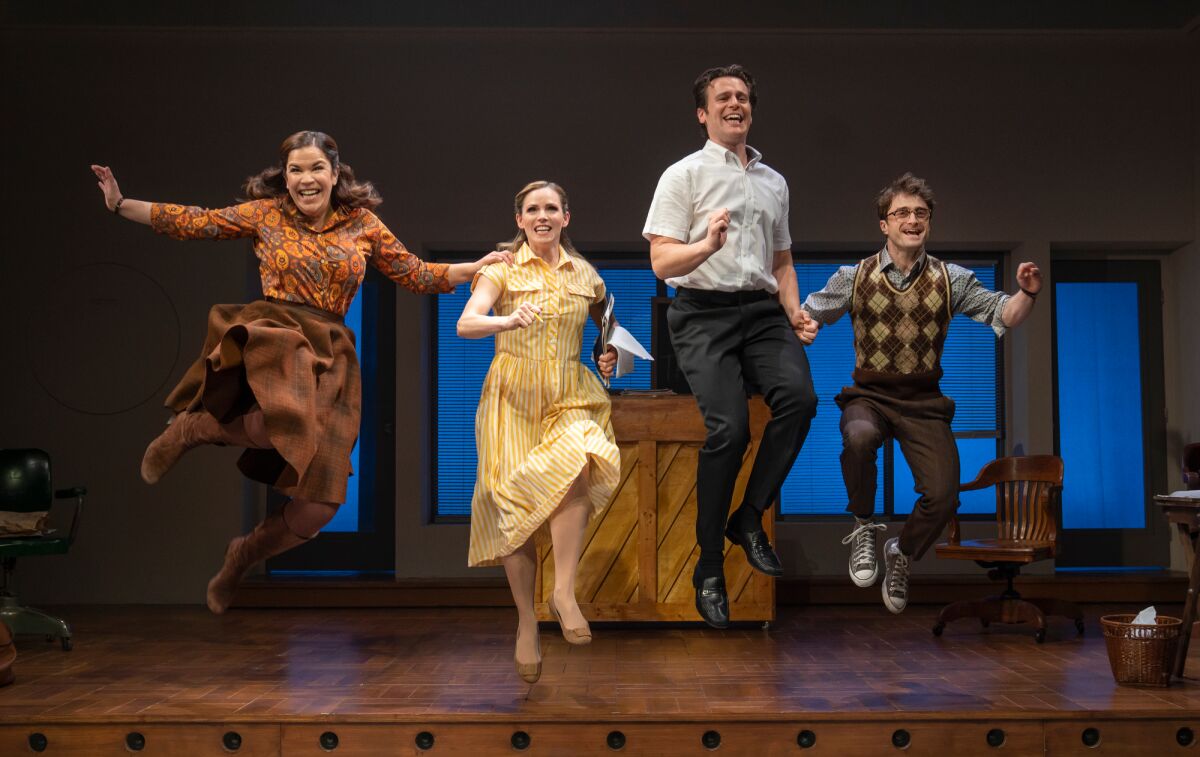
Katie Rose Clarke (second from left) as Beth, alongside Lindsay Mendez, Jonathan Groff and Daniel Radcliffe, in “Merrily We Roll Along,” which transfers to Broadway in September.
(Joan Marcus)
Coleman: I also did “Into the Woods,” in high school. I hadn’t heard of Sondheim before, and got cast as the Baker’s Wife. I remember hearing Joanna Gleason’s incredible voice on the cast album and realizing that you don’t have to put a hat on a hat on a hat, you don’t have to add too much to these songs in order to communicate their truths. I 100% attribute that production to why I pursue this professionally today.
Dandridge: Of course, mine was also “Into the Woods” in high school. My choir director rolled out that big old TV with a thick VHS player to show us the PBS presentation, and then I got cast as the Witch, my first leading role. I absolutely fell in love with it. My music theory sensibilities were so piqued and I found myself so interested in this profound investigation into humanity. I honestly think that Sondheim was my first therapist. It sparked a fire in me to pursue this kind of work as a career.
Clarke: I was a college freshman when I auditioned for a production of “Company” — I didn’t get cast, but I ended up assisting on the soundboard, so I watched the show over and over again. It was my first exposure to material like that, because my high school musicals were not that substantive, as far as the material goes, and even in college, it’s still a little bit over our heads. I fell in love with Sondheim from watching the actors try to navigate that material every night.

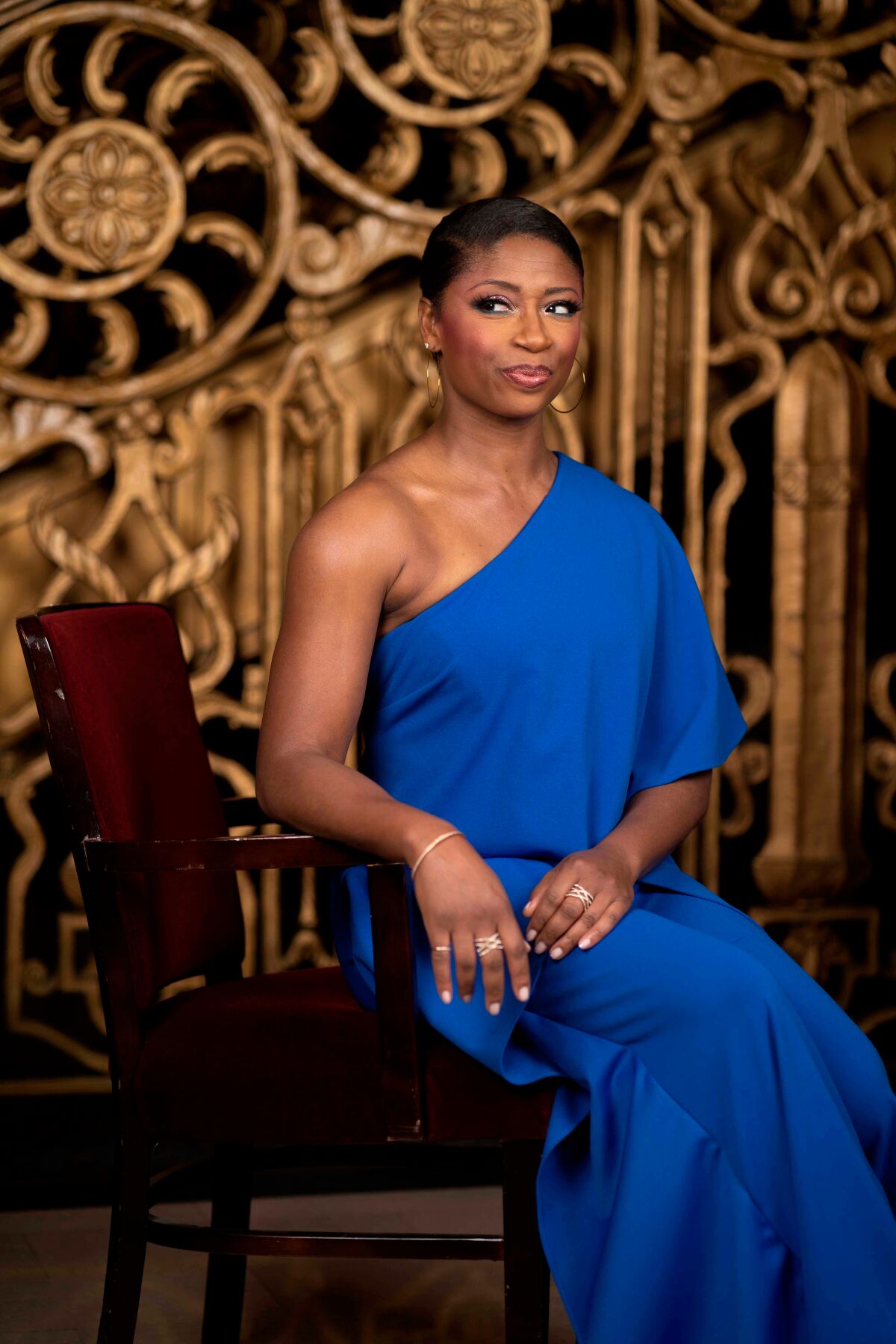
(Christian K. Lee / For The Times)
“Sondheim is for everyone – not just artists, not just Broadway, not just people in New York, but everyone.”
— Montego Glover

I admit, I’ve had to grow into much of Sondheim’s work. At this point in your life, what are you discovering about the character you play that you hadn’t seen before?
Glover: This “Into the Woods” has some props and no set. It’s very simple storytelling — I mean, the Wolf eats Little Red and it’s literally a pillow under a quilt! It did not cost $10 million, it’s not a heavy-tech element and it works beautifully because it allows what lives inside of actors to come forward. To my delight, things about the Witch that might have been lost on me five, 10, 20 years ago are now like bells ringing so loud and marvelous and unnerving and hopeful and sad — all of it, at the same time. It gets higher and wider and deeper, and it never stops. I’m learning so much about myself, my own skill set and just profound truths about life.
Dandridge: In some ways, I liken Sondheim to Shakespeare in that there’s always something more in the text that maybe I missed or am hearing differently. I went into “A Little Night Music” thinking I knew it, and that someday I’ll play Desiree. But here I am, suddenly old enough to play Desiree, and I am overwhelmingly surprised by how little I knew about the character and this piece. And when you put your voice and your spirit into it, it’s a completely different animal. It’s refreshing and wonderful — Desiree is teaching me, healing me and giving me so much joy.
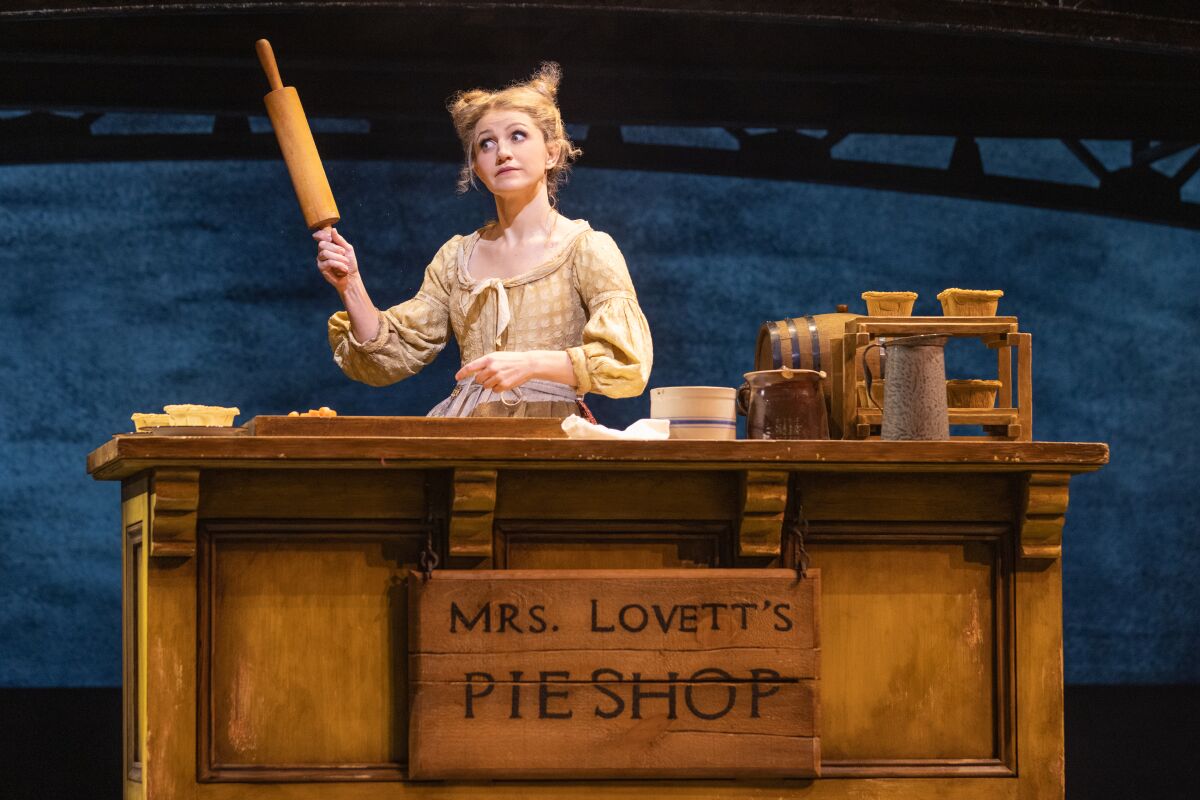
Annaleigh Ashford as Mrs. Lovett in “Sweeney Todd,” now playing on Broadway.
(Matthew Murphy and Evan Zimmerman)
Clarke: This is my first time performing a Sondheim show. I love Beth [in “Merrily We Roll Along”] so much because she loves so selflessly and fiercely. She’s a mother and she’s experiencing extreme heartbreak and loss. I’m fundamentally a different person since becoming a mom; I approach situations a little bit differently now and I think about things a little bit differently. I know I couldn’t have approached Beth in the same way before having kids myself. It’s exciting that we get to bring our own truth to these stories every night.
Coleman: Like Bobbie [in “Company”], I’ll be turning 35 two months into the tour, and I don’t have a ring on my finger! So I’m grateful for the two-and-a-half-hour-long therapy sessions, and that I will get to bring the country along with me. It’s going to be an incredible privilege to perform “Being Alive” on a bare stage to 3,000-seat houses across the U.S., especially for someone who looks like me. I definitely didn’t grow up seeing women who looked like me lead Sondheim shows, and seeing this panel, in particular, makes me very excited and emotional.
Ashford: It’s like what Sondheim wrote in “Sunday in the Park With George.” “Anything you do, let it come from you. Then it will be new. Give us more to see…” I try to remind myself that this is where I’m supposed to be at this very moment, and whatever comes to the forefront in my body and spirit is what [Mrs. Lovett in “Sweeney Todd”] will be. And I sometimes say a prayer, like, “Alright, Steve, I can’t wait to do puzzles with you tonight,” and do a puzzle in my dressing room. It’s my little thank you to Steve because he loved puzzles, and definitely a reminder that you’re the person doing this puzzle right now.


(Sophie Park / For The Times)
“I love that his shows don’t spoon feed the audience on how to feel.”
— Britney Coleman

As performers inside these shows, what about Sondheim or these revivals do you wish other musical theater producers or creators would adopt more liberally?
Dandridge: Something that’s sticking out to me in our conversation is how much in Sondheim is given to the artist for their interpretation. Britney, you touched on it — historically, the place of people of color in the Sondheim canon. So what on Earth is someone who looks like me doing in 1900s Sweden? I am Black and Korean, and in our production, my mother Madame Armfeldt has been cast as an Asian actress [Jodi Long] because, hey, there was a trade alliance between Sweden and Japan that would have come at the time period that Desiree and Fredrik might have fallen in love for the first time! There is space for everyone and their stories to be elucidated and celebrated in his work because it’s our humanity and our sameness that’s reflected in the text.
Coleman: Yeah. His work not only lets the actor have a moment for interpretation, but also lets the audience have a moment for interpretation. I love that his shows don’t spoon feed the audience on how to feel. A lot of these shows are actually quite polarizing to a lot of people, which is interesting and creates a lot of excellent post-show conversation. So more of that, please.
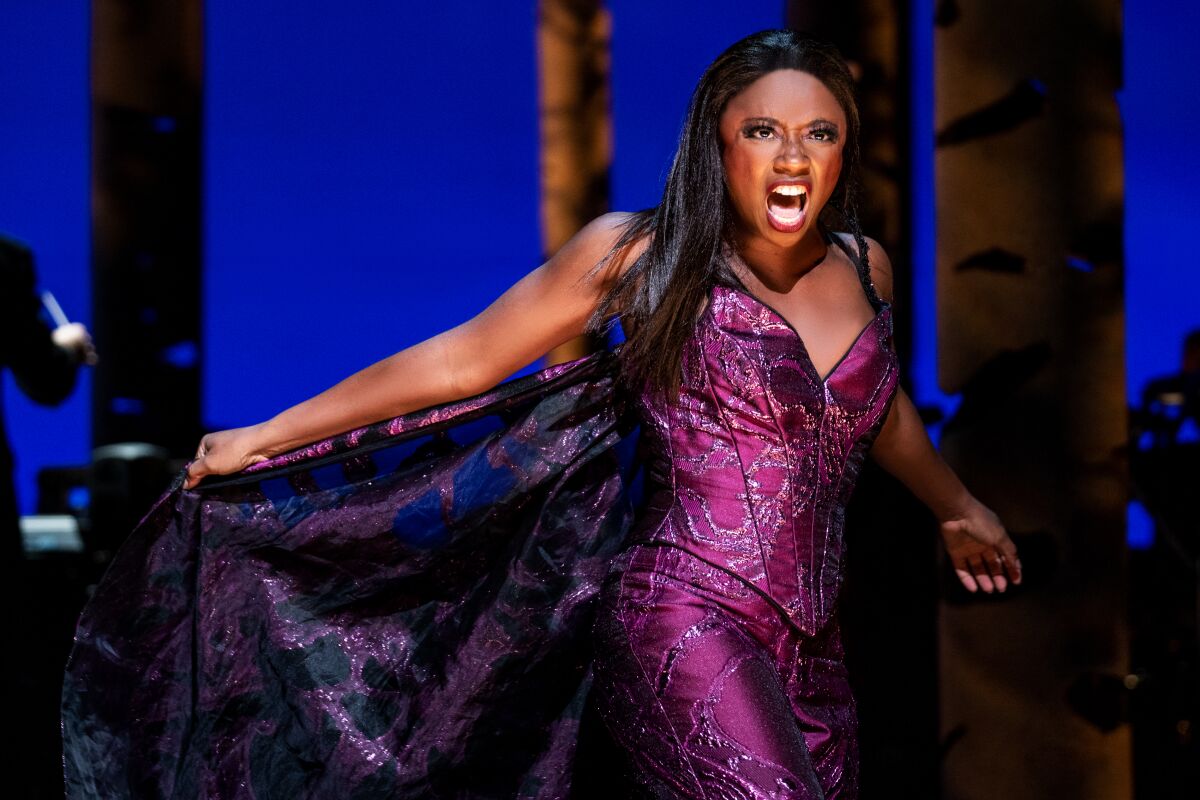
Montego Glover as the Witch in the national tour of “Into the Woods,” which arrives at the Ahmanson Theatre in June.
(Matthew Murphy and Evan Zimmerman)
Ashford: His body of work for women is extraordinary. The two Sondheim roles I’ve done are “Sunday in the Park With George,” originally created by Bernadette Peters, and “Sweeney Todd,” originally created by Angela Lansbury. These are two big shows about a man that are crafted as a two-hander, with very strong, complicated, dynamic female characters who ultimately have more interesting arcs than the male characters. Maybe, because I played them, they were more interesting to me, but Steve always was interested in making sure that the female counterpoint was equal. He was just authentically interested in good storytelling, and that’s telling the whole, full story of all the humans.
Glover: I feel like Stephen was one of those people who allowed his work to germinate and grow, and he was not in a hurry. I think that’s where you can get into trouble and maybe don’t do your best work. To anyone who is working on anything new right now: Trust your own writing. If you feel you need to gild the lily, then keep working.
Clarke: “Merrily” was one that he continued to work on and refine, because it’s notoriously his biggest flop. And yet, it’s so rich — you could take out any small piece of a song and there’s richness just in that one little tiny nugget within the song. I hope artists always work toward making something more serving to the human experience, something that can actually speak to people and call them to something better.


(Justin Jun Lee / For The Times)
“If you get the opportunity to do Sondheim, you take it, no matter what time and space and place it is.”
— Annaleigh Ashford

You each have at least one iconic song of which devout theater fans inevitably anticipate your take. What’s the most challenging part of that number for you? For example, Annaleigh, where do you breathe in “By the Sea?”
Ashford: I know Steve would have had an opinion about that! I almost emailed him to ask him about little things like that, and I thought, “I’ll wait to get those answers at our first reading.” That ended up being the Monday after he passed away, which was heartbreaking. But I feel like he provides me answers through the text, through all of these women on all of these recordings, ladies who spent time with Steve while they were creating. It’s lovely to have that tape and know that people have been doing this material for years.
Coleman: Bobbie has a whole journey in “Being Alive” that almost feels like it’s on fast-forward: It starts off introspective and quiet, and the realization at the end is a big leap. Trying to make sense of that every night is the hardest part, but I’m in the midst of exploring it.
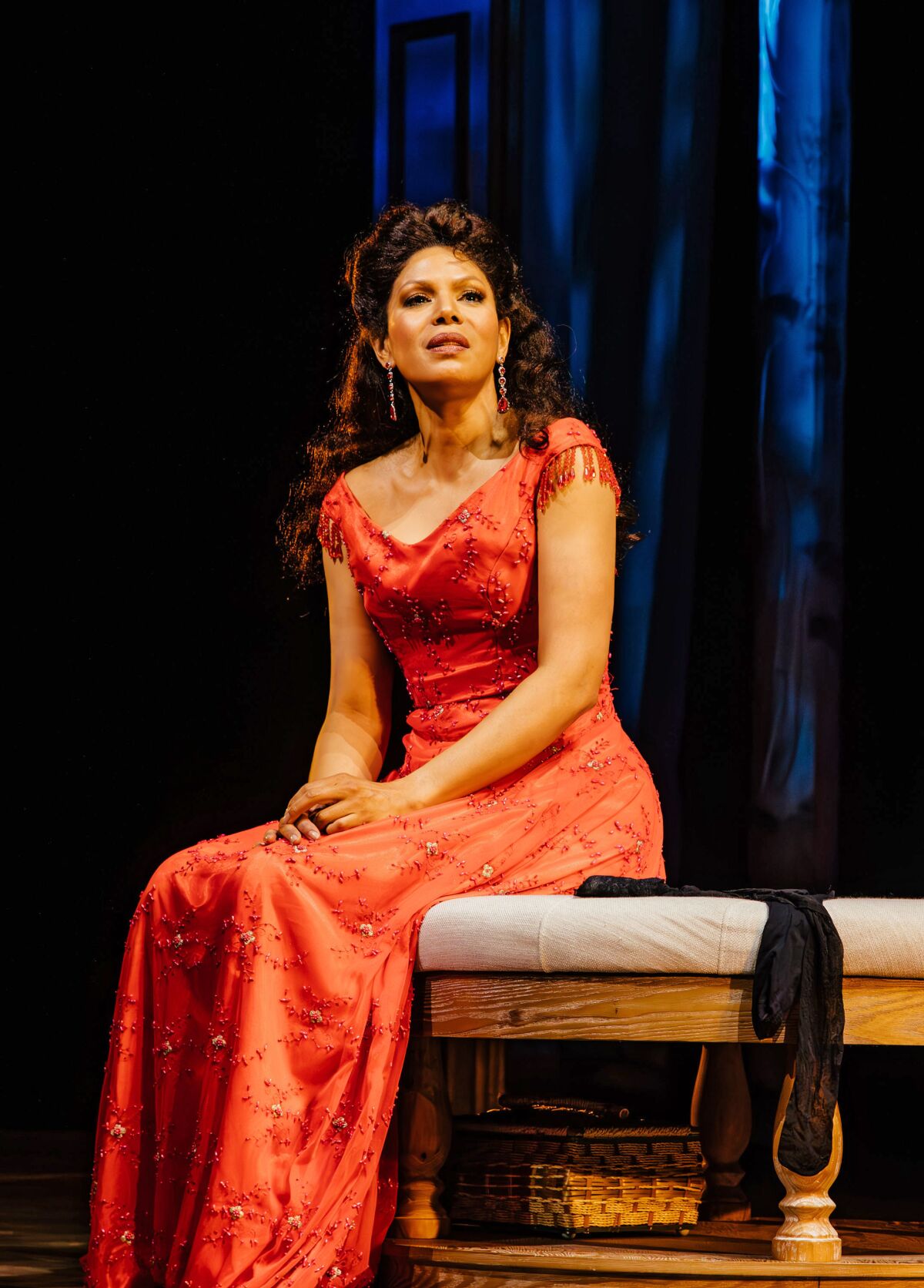
Merle Dandridge as Desiree Armfeldt in “A Little Night Music,” running at the Pasadena Playhouse through May 28.
(Jeff Lorch)
Dandridge: Again, I thought I knew “Send in the Clowns,” but when I sat down to actually sing it, I was like, “I don’t know this song at all!” And surprisingly, the song has never come out of me the same way twice, which is a different process for me because vocally, I’ve always been a planner. This song is messy and emotional, and the restraint of it is something that catches in my throat and arrests my spirit at times.
It’s also extremely low, which strips me of any techniques or tricks and forces me to be extremely vulnerable and completely honest. I learned it was originally written in a higher key, so I spent some time singing it in that key and I’m still curious about it. But there’s a reason it went into this low space, so I’m trusting him and honoring that choice.
Clarke: “Not a Day Goes By” first makes its appearance when Beth is getting a divorce, so it’s a very broken moment. It was challenging, especially in the first rehearsals, to not give over to the emotional satisfaction of singing that song then, because with each new scene, there’s a time jump and we have to start fresh as if what we just performed hasn’t happened yet. Like Merle said, it’s in keeping it simple and trusting this beautiful representation of complicated things. I hear from people often that the more devastating version of the song is the second one, when she’s getting married, because that scene is so informed by everything the audience has already seen.
Glover: Is it “Stay With Me” or “Witch’s Lament” or “Last Midnight?” I’m still deciding which of the Witch’s songs is the song because, for me, they’re all connected and necessary to her underpinnings. The difficulty every night is staying on the beam, from “Greens” to “Children Will Listen,” and holding it all with a kind of accuracy and emotional will.


(Justin Jun Lee / For The Times)
“The overwhelming audience feedback that I get is that our show makes them think back on their own lives in
new ways.”
— Katie Rose Clarke

Not all Sondheim premieres were decorated hits. This time around, what do you notice about the audiences of these revivals?
Ashford: I think Steve would’ve been so delighted in the volume of folks seeing his shows — people who have seen [previous Broadway productions of “Sweeney Todd”], but also, young people seeing it for the first time. That’s what theater is supposed to be — communal, from the young to the old. And I’m thrilled when I hear gasps because they didn’t know the ending; sometimes people shriek because it’s so shocking to them.
Glover: On the road, I’m noticing that people coming to see the show don’t really know it, but they get incredibly connected to it because it’s this glorious vehicle of truth. I see husbands and wives looking at each other and having silent conversations as the Baker and his wife [share a scene]. I hear mothers exclaiming in exhaustion as Jack’s mother is trying to explain something! I can tell you, the line “I don’t make policy. I just carried it out” brought the house down in [Washington,] D.C. So it’s turning out that Sondheim is for everyone — not just artists, not just Broadway, not just people in New York, but everyone.
Coleman: “Company” allows the audience to have an opinion on Bobbie and all of these relationships around her. There are even moments when she checks in with the audience on this journey, like, “Are you thinking the same thing I’m thinking?” And I love the ending, after “Being Alive,” when she comes back to this birthday cake with candles she’s been trying to blow out for two and a half hours. She finally does, but you don’t actually know what she wished for, and that’s OK. That she made a decision is the achievement.
Dandridge: This all makes me think of that famous Chekhov quote: “The role of the artist is to ask questions, not answer them.” One of my all-time favorite Sondheim shows is “Passion,” which disturbed me so deeply in all the best ways. I think that’s because I encountered it when I was first figuring out what it means to be in love. In investigating these questions, the answers are so vast and broad and nuanced because there are so many ways to interpret and learn from the way he presents these characters and their journeys.
Clarke: Yes, and that’s what audiences are responding to. The overwhelming audience feedback that I get is that our show makes them think back on their own lives in new ways. Whenever we jump in time, we actually break the fourth wall, look at the audience and ask questions like, “How did you get there from here? Why are you here?” It’s exciting to see audiences respond so introspectively by taking it in and taking stock of their own experiences.


Stephen Sondheim, photographed in 2014, died in late 2021.
(Carolyn Cole / Los Angeles Times)
Last question: If you could play any role in any Sondheim show, what would it be?
Glover: Dot, “Sunday in the Park With George.”
Dandridge: As a full-circle moment, because I played the Witch [in “Into the Woods”] when I was 16, I think I have to do it again.
Clarke: I’d do anything he’s written. Honestly, any role I could score, I would absolutely jump at the chance to do.
Ashford: I’ve always loved the stripper section of “Gypsy.” I’d like to play Electra, but when I’m 80. I want to almost be naked onstage in a way that makes people very uncomfortable and question how they feel about age and their body. Maybe my walker can light up.
Coleman: I think I still have a hot second to play Louise [in “Gypsy”].
Ashford: We could all do “Follies” together in another 40 years. Talk about a plethora of women’s roles!
Dandridge: I’m gonna hold you to that, Annaleigh! We’re doing it.
Glover: Yes, we’re doing that.









